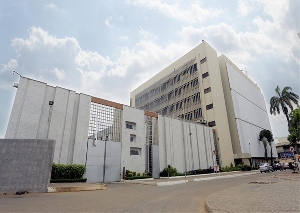Banks appear more willing to keep a decent portion of their deposits as reserves with the Bank of Ghana (BoG) than lend to businesses and households, latest data from the regulator suggest.
According to the new figures, private sector credit growth has significantly slowed down. Year-on-year growth dropped from nearly 19.8 percent in April 2023 to 10.8 percent in April 2024. Even after adjusting for inflation, credit to businesses has contracted by 11.4 percent compared to the 15.2 percent contraction recorded over the same period last year.
At the same time, the portion of deposits that commercial banks keep with the apex bank grew from 46.5 percent in April 2023 to 51.9 percent this year, with the new cash reserve ratio directive attributed as the primary cause.
“Commercial banks’ reserves with the central bank surged following implementation of the dynamic Cash Reserve Requirement (CRR). As at end-April 2024 reserve money growth, on a year-on-year basis, had increased to 51.9 percent (mainly due to the changes in regulatory reserves) relative to a growth of 46.5 percent in April 2023,” BoG Governor Dr. Ernest Addison said during a press briefing for the 118th Monetary Policy Committee (MPC) meetings.
The central bank said it introduced the measure in a bid to dissuade banks from investing in government securities – primarily Treasury bills – to the detriment of private sector credit. It was also a means of mopping up excess liquidity.
The new CRR system introduced a tiered structure, with banks maintaining a lower CRR – essentially holding less money in reserves – if they demonstrate a higher loan-to-deposit (L/D) ratio. Stated differently, the more loans banks extended, the less money they had to keep with the BoG as reserves.
Effective April 1, 2024, the new policy mandates banks with loan-to-deposit ratios (LDR) exceeding 55 percent to maintain 15 percent of their deposits as reserves (CRR), while those with ratios below 40 percent must hold at least 25 percent of deposits in reserves.
At the time, Dr. Ernest Addison reported a sharp decline in private-sector lending.
In February 2024, credit growth to businesses was only 5.1 percent -down significantly from 29.5 percent a year earlier.
This coincided with banks increasingly investing their money in government bonds. These investments reached GH¢53.6billion by February 2024, a much faster year-on-year rise (67.6 percent) compared to a 36.9 percent increase the previous year.
This came despite banks witnessing a substantial increase in deposits. Following the Domestic Debt Exchange Programme, deposits grew by 25.5 percent year-on-year to GH¢224.4billion in February 2024.
Some analysts have suggested that while it is early days and definite conclusions cannot be made at the moment, the development points to banks trying to find alternatives to lending to the private sector.
“Let us be serious; banks are not going to increase lending in this high-risk environment and risk raising their NPLs (non-performing loan ratio), which will only invite more scrutiny from the central bank,” an analyst who sought anonymity said.
This comes as BoG data showed that the industry’s NPL ratio stood at 25.7 percent in April 2024 versus 18 percent a year ago, with the central bank attributing this to “the lagged effect of COVID-19 pandemic and economic crisis of 2022 which led to the downgrading of several large exposures of banks”.
The industry remained on the path to recovery, the BoG stated, as total assets increased by 28.8 percent to GH¢306.8billion at the end of April 2024 driven by domestic currency deposits and other funding sources.
Banks also reported higher profits for the first four months of 2024 compared to the same period in 2023.
“Key financial soundness indicators generally improved during the review period. The capital adequacy ratio adjusted for reliefs increased to 15.5 percent in April 2024 from 14.7 percent in April 2023, reflecting the rebound in profits. The capital adequacy ratio without relief for the banking system was 11.5 percent at the end of April 2024 compared to 7.6 percent in April 2023. Liquidity and efficiency indicators also improved in April 2024 compared to the same period last year,” Governor Addison further stated.
Business News of Tuesday, 28 May 2024
Source: thebftonline.com

















